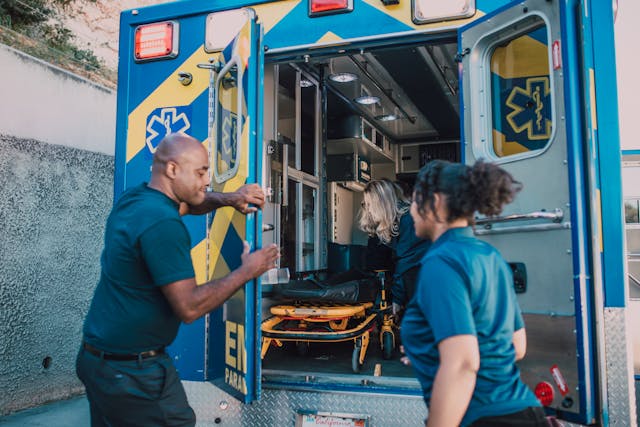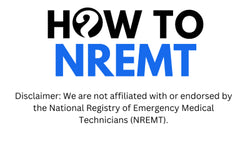Your Step-by-Step Guide to Becoming an EMT in Washington
Want to become an EMT in Washington? Whether you’re passionate about emergency medicine, want to serve your community, or are exploring a path toward a healthcare career, earning your EMT-B certification is an exciting first step.
Washington’s EMT process includes approved training, NREMT exam success, and a few state-specific requirements. That’s where we come in. At How To NREMT, we make preparation simple and structured—with our EMT national training resources, NREMT tutors, and a 10-step study plan tailored to your success. You bring the commitment. We’ll provide the tools.
Step 01

Make Sure You’re Eligible
Before applying for an EMT program in Washington, here’s what you need to know:
- Be at least 18 years old
- Hold a high school diploma or GED
- Have a valid Healthcare Provider-level BLS CPR certification
- Be physically and mentally fit to perform EMT duties
- Pass a criminal background check through fingerprinting
- Be affiliated with a licensed EMS agency or supervisory organization
- Get a Medical Program Director’s (MPD) recommendation
Washington has additional rules not found in every state: your training and certification application must be connected to an EMS agency or emergency services supervisory organization (ESSO), and you must be under the oversight of your county's Medical Program Director. This ensures you’re connected to real-world prehospital care from the start.
Step 02

Enroll in a Washington-Approved EMT Course
Washington requires all EMT-B candidates to complete an approved training program. Courses are typically offered at:
- Community & Technical Colleges (e.g., Spokane CC, Tacoma CC, Walla Walla CC)
- Technical Colleges (e.g., Bates Technical College, Bellingham Technical College)
- Local EMS councils or fire departments
These programs follow the National EMS Education Standards and include at least 150 hours of classroom, lab, and scenario-based instruction, ending with a skills competency exam administered by DOH-approved evaluators. Your final evaluation confirms that you’ve mastered the core skills required for licensure.
When choosing a program, be sure it’s on the Washington DOH’s list of approved training centers.
Step 03

Get Your CPR Certification
A valid CPR certification is required before, during, and after your EMT training. Washington accepts:
- American Heart Association (AHA) BLS for Healthcare Providers
- Red Cross BLS certification
- CAPCE-accredited CPR courses with hands-on skills checks
Online-only CPR certifications without an in-person skills test are not accepted. Your CPR course must cover adult, child, and infant CPR, AED usage, and bag-mask ventilation.
Most EMT courses help you obtain or renew your CPR certification as part of the enrollment process.
Step 04

Pass the NREMT Cognitive Exam
Once your training is complete, you’ll need to pass the NREMT cognitive exam, which is required for certification in Washington. The exam was updated in April 2025 with a new structure that better reflects real-world EMT work.
Here’s what to expect:
New Domains of the 2025 NREMT Exam:
- Scene Size-Up & Safety (15–19%)– PPE, environmental awareness, triage
- Primary Assessment (39–43%)– LOC, ABCs, life threats
- Secondary Assessment (5–9%)– vitals, focused exam, history taking
- Patient Treatment & Transport (20–24%)– interventions, immobilization, medications
- Operations (10–14%)– documentation, communication, EMS safety, equipment
Pediatric care is now integrated throughout all sections.
Technology-Enhanced Items (TEIs) like drag-and-drop, check-boxes, and ordered lists are included.
This isn’t your typical multiple-choice test—TEIs are designed to challenge your clinical thinking. But don’t worry: our EMT tutors and NREMT prep tools are built around this exact format, so you’ll walk in feeling prepared.
Step 05

Demonstrate Skills Competency (Within Your Course)
In Washington, you don’t need to take a separate psychomotor exam after class. Instead, you’ll complete a Terminal Competency Evaluation at the end of your EMT course. This evaluation is conducted by DOH-approved evaluators and confirms your ability to perform:
- Patient assessment
- CPR and AED procedures
- Airway management
- Bleeding control and shock care
- Splinting and spinal immobilization
Once you’ve passed this within your program, your training center will document your success and prepare you for state licensure.
Step 06

Apply for Your Washington EMT License
After completing your course and passing the NREMT cognitive exam, it’s time to get licensed through the Washington Department of Health (DOH). Here’s how:
- Create a SAW (Secure Access Washington) account
Go to Secure Access Washington website and sign up. - Access the EMS Online Certification system
Add the “EMS Online Certification” service to your account and verify your identity. - Submit your Application
Upload your CPR card, training documents, NREMT results, and MPD recommendation. If this is your first license, the state will send instructions for fingerprint-based background checks. - Affiliation Required
You must list your EMS agency on the application. Without an EMS affiliation and MPD sign-off, your application can’t be approved.
Once everything’s verified, Washington DOH will issue your EMT-B license—allowing you to start work with your agency.
NREMT vs. Washington Requirements
| Requirement | NREMT (National) | Washington State DOH |
|---|---|---|
| Minimum Age | Varies by state | 18 years old minimum |
| Education | High school diploma/GED recommended | High school diploma or GED required |
| EMT Course | NREMT-approved or state-equivalent | Washington DOH-approved EMT program |
| CPR Certification | AHA BLS or equivalent | BLS with in-person skills check required |
| Skills Testing | Program-based psychomotor evaluation | Completed within course by DOH evaluators |
| Cognitive Exam | NREMT cognitive exam (Pearson VUE) | Same (required for state certification) |
| EMS Agency Affiliation | Not required | Required for certification |
| Medical Director Approval | Not applicable | Required recommendation from county MPD |
| Background Check | Not always required | FBI fingerprint check required |
| State Application | No (just registration) | Apply via EMS Online Certification Portal |

- Choosing a selection results in a full page refresh.



